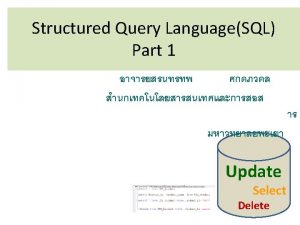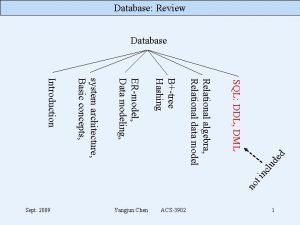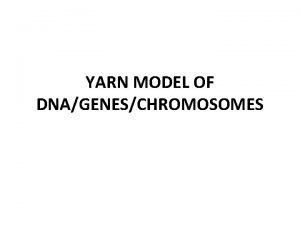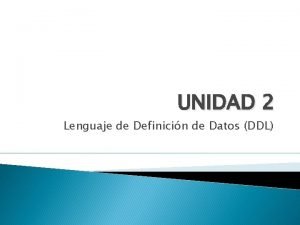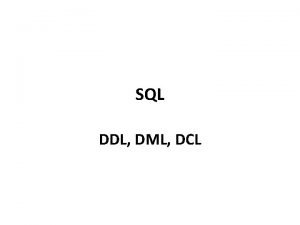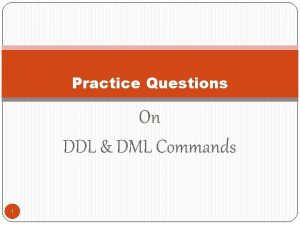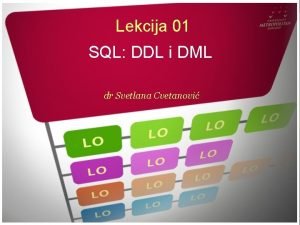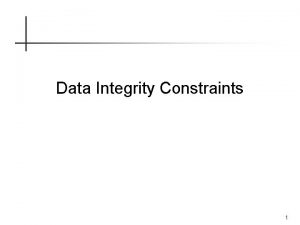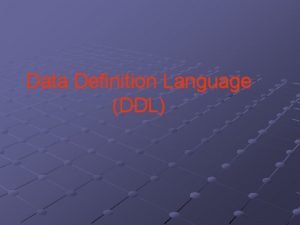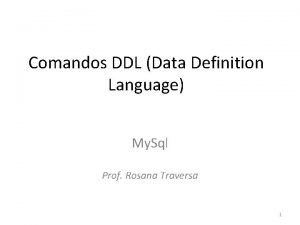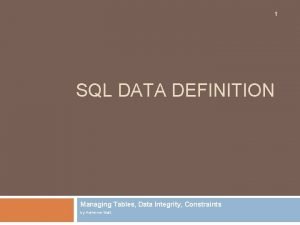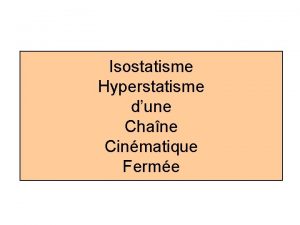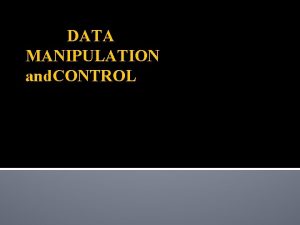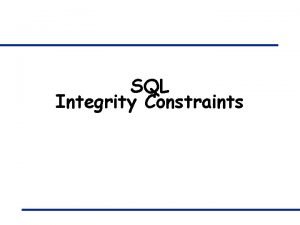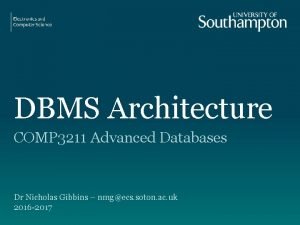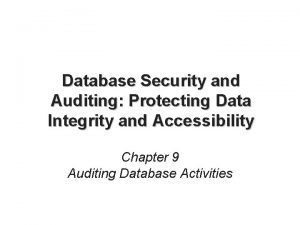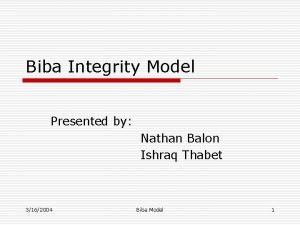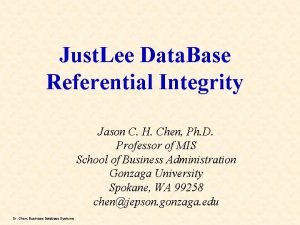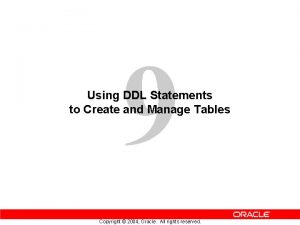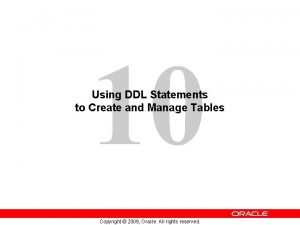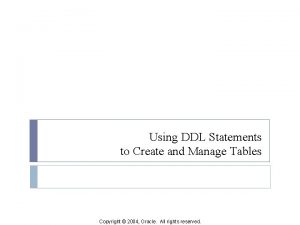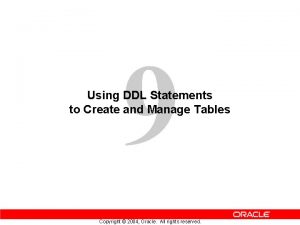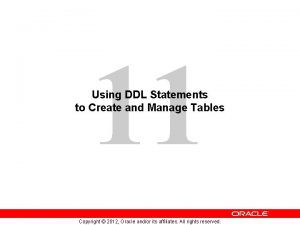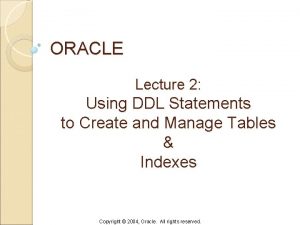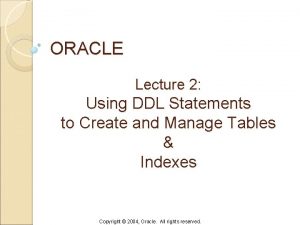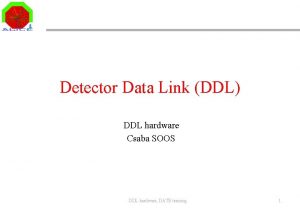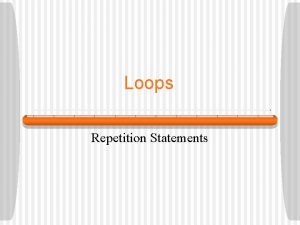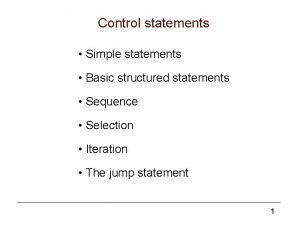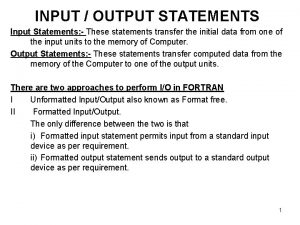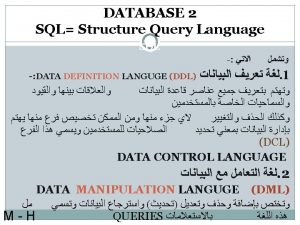9 Using DDL Statements to Create and Manage














![Defining Constraints • Syntax: CREATE TABLE [schema. ]table (column datatype [DEFAULT expr] [column_constraint], . Defining Constraints • Syntax: CREATE TABLE [schema. ]table (column datatype [DEFAULT expr] [column_constraint], .](https://slidetodoc.com/presentation_image_h/2f8b4284a9fe87cc01f6c59c9e7eb0b1/image-15.jpg)


















- Slides: 33

9 Using DDL Statements to Create and Manage Tables Copyright © 2006, Oracle. All rights reserved.

Objectives After completing this lesson, you should be able to do the following: • Categorize the main database objects • Review the table structure • List the data types that are available for columns • Create a simple table • Explain how constraints are created at the time of table creation • Describe how schema objects work 9 -2 Copyright © 2006, Oracle. All rights reserved.

Database Objects 9 -3 Object Description Table Basic unit of storage; composed of rows View Logically represents subsets of data from one or more tables Sequence Generates numeric values Index Improves the performance of some queries Synonym Gives alternative names to objects Copyright © 2006, Oracle. All rights reserved.

Naming Rules Table names and column names: • Must begin with a letter • Must be 1– 30 characters long • Must contain only A–Z, a–z, 0– 9, _, $, and # • Must not duplicate the name of another object owned by the same user • Must not be an Oracle server–reserved word 9 -4 Copyright © 2006, Oracle. All rights reserved.

CREATE TABLE Statement • You must have: – CREATE TABLE privilege – A storage area CREATE TABLE [schema. ]table (column datatype [DEFAULT expr][, . . . ]); • You specify: – Table name – Column name, column data type, and column size 9 -5 Copyright © 2006, Oracle. All rights reserved.

Referencing Another User’s Tables • Tables belonging to other users are not in the user’s schema. • You should use the owner’s name as a prefix to those tables. 9 -6 USERA USERB SELECT * FROM user. B. employees; SELECT * FROM user. A. employees; Copyright © 2006, Oracle. All rights reserved.

DEFAULT Option • Specify a default value for a column during an insert. . hire_date DATE DEFAULT SYSDATE, . . . • Literal values, expressions, or SQL functions are legal values. • Another column’s name or a pseudocolumn are illegal values. • The default data type must match the column data type. CREATE TABLE hire_dates (id NUMBER(8), hire_date DATE DEFAULT SYSDATE); Table created. 9 -7 Copyright © 2006, Oracle. All rights reserved.

Creating Tables • Create the table. CREATE TABLE dept (deptno dname loc create_date Table created. NUMBER(2), VARCHAR 2(14), VARCHAR 2(13), DATE DEFAULT SYSDATE); • Confirm table creation. DESCRIBE dept 9 -8 Copyright © 2006, Oracle. All rights reserved.

Data Types Data Type Description VARCHAR 2(size) Variable-length character data 9 -9 CHAR(size) Fixed-length character data NUMBER(p, s) Variable-length numeric data DATE Date and time values LONG Variable-length character data (up to 2 GB) CLOB Character data (up to 4 GB) RAW and LONG RAW Raw binary data BLOB Binary data (up to 4 GB) BFILE Binary data stored in an external file (up to 4 GB) ROWID A base-64 number system representing the unique address of a row in its table Copyright © 2006, Oracle. All rights reserved.

Datetime Data Types You can use several datetime data types: Data Type 9 - 11 Description TIMESTAMP Date with fractional seconds INTERVAL YEAR TO MONTH Stored as an interval of years and months INTERVAL DAY TO SECOND Stored as an interval of days, hours, minutes, and seconds Copyright © 2006, Oracle. All rights reserved.

Datetime Data Types • The TIMESTAMP data type is an extension of the DATE data type. • It stores the year, month, and day of the DATE data type plus hour, minute, and second values as well as the fractional second value. • You can optionally specify the time zone. TIMESTAMP[(fractional_seconds_precision)] WITH TIME ZONE TIMESTAMP[(fractional_seconds_precision)] WITH LOCAL TIME ZONE 9 - 12 Copyright © 2006, Oracle. All rights reserved.

Datetime Data Types • The INTERVAL YEAR TO MONTH data type stores a period of time using the YEAR and MONTH datetime fields: INTERVAL YEAR [(year_precision)] TO MONTH • The INTERVAL DAY TO SECOND data type stores a period of time in terms of days, hours, minutes, and seconds: INTERVAL DAY [(day_precision)] TO SECOND [(fractional_seconds_precision)] 9 - 14 Copyright © 2006, Oracle. All rights reserved.

Including Constraints • Constraints enforce rules at the table level. • Constraints prevent the deletion of a table if there are dependencies. • The following constraint types are valid: – – – 9 - 17 NOT NULL UNIQUE PRIMARY KEY FOREIGN KEY CHECK Copyright © 2006, Oracle. All rights reserved.

Constraint Guidelines • You can name a constraint, or the Oracle server generates a name by using the SYS_Cn format. • Create a constraint at either of the following times: – At the same time as the table is created – After the table has been created • Define a constraint at the column or table level. • View a constraint in the data dictionary. 9 - 18 Copyright © 2006, Oracle. All rights reserved.
![Defining Constraints Syntax CREATE TABLE schema table column datatype DEFAULT expr columnconstraint Defining Constraints • Syntax: CREATE TABLE [schema. ]table (column datatype [DEFAULT expr] [column_constraint], .](https://slidetodoc.com/presentation_image_h/2f8b4284a9fe87cc01f6c59c9e7eb0b1/image-15.jpg)
Defining Constraints • Syntax: CREATE TABLE [schema. ]table (column datatype [DEFAULT expr] [column_constraint], . . . [table_constraint][, . . . ]); • Column-level constraint: column [CONSTRAINT constraint_name] constraint_type, • Table-level constraint: column, . . . [CONSTRAINT constraint_name] constraint_type (column, . . . ), 9 - 19 Copyright © 2006, Oracle. All rights reserved.

Defining Constraints • Column-level constraint: CREATE TABLE employees( employee_id NUMBER(6) CONSTRAINT emp_id_pk PRIMARY KEY, first_name VARCHAR 2(20), . . . ); 1 • Table-level constraint: CREATE TABLE employees( employee_id NUMBER(6), first_name VARCHAR 2(20), . . . job_id VARCHAR 2(10) NOT NULL, CONSTRAINT emp_id_pk PRIMARY KEY (EMPLOYEE_ID)); 9 - 20 Copyright © 2006, Oracle. All rights reserved. 2

NOT NULL Constraint Ensures that null values are not permitted for the column: … NOT NULL constraint (No row can contain a null value for this column. ) 9 - 21 NOT NULL constraint Absence of NOT NULL constraint (Any row can contain a null value for this column. ) Copyright © 2006, Oracle. All rights reserved.

UNIQUE Constraint UNIQUE constraint EMPLOYEES … INSERT INTO Allowed Not allowed: already exists 9 - 22 Copyright © 2006, Oracle. All rights reserved.

UNIQUE Constraint Defined at either the table level or the column level: CREATE TABLE employees( employee_id NUMBER(6), last_name VARCHAR 2(25) NOT NULL, email VARCHAR 2(25), salary NUMBER(8, 2), commission_pct NUMBER(2, 2), hire_date DATE NOT NULL, . . . CONSTRAINT emp_email_uk UNIQUE(email)); 9 - 23 Copyright © 2006, Oracle. All rights reserved.

PRIMARY KEY Constraint DEPARTMENTS PRIMARY KEY … Not allowed (null value) INSERT INTO Not allowed (50 already exists) 9 - 24 Copyright © 2006, Oracle. All rights reserved.

FOREIGN KEY Constraint DEPARTMENTS PRIMARY KEY … EMPLOYEES FOREIGN KEY … INSERT INTO Not allowed (9 does not exist) Allowed 9 - 25 Copyright © 2006, Oracle. All rights reserved.

FOREIGN KEY Constraint Defined at either the table level or the column level: CREATE TABLE employees( employee_id NUMBER(6), last_name VARCHAR 2(25) NOT NULL, email VARCHAR 2(25), salary NUMBER(8, 2), commission_pct NUMBER(2, 2), hire_date DATE NOT NULL, . . . department_id NUMBER(4), CONSTRAINT emp_dept_fk FOREIGN KEY (department_id) REFERENCES departments(department_id), CONSTRAINT emp_email_uk UNIQUE(email)); 9 - 26 Copyright © 2006, Oracle. All rights reserved.

FOREIGN KEY Constraint: Keywords • FOREIGN KEY: Defines the column in the child table at the table-constraint level • REFERENCES: Identifies the table and column in the parent table • ON DELETE CASCADE: Deletes the dependent rows in the child table when a row in the parent table is deleted • ON DELETE SET NULL: Converts dependent foreign key values to null 9 - 27 Copyright © 2006, Oracle. All rights reserved.

CHECK Constraint • Defines a condition that each row must satisfy • The following expressions are not allowed: – References to CURRVAL, NEXTVAL, LEVEL, and ROWNUM pseudocolumns – Calls to SYSDATE, UID, USER, and USERENV functions – Queries that refer to other values in other rows. . . , salary NUMBER(2) CONSTRAINT emp_salary_min CHECK (salary > 0), . . . 9 - 28 Copyright © 2006, Oracle. All rights reserved.

CREATE TABLE: Example CREATE TABLE employees ( employee_id NUMBER(6) CONSTRAINT emp_employee_id , first_name VARCHAR 2(20) , last_name VARCHAR 2(25) CONSTRAINT emp_last_name_nn , email VARCHAR 2(25) CONSTRAINT emp_email_nn CONSTRAINT emp_email_uk , phone_number VARCHAR 2(20) , hire_date DATE CONSTRAINT emp_hire_date_nn , job_id VARCHAR 2(10) CONSTRAINT emp_job_nn , salary NUMBER(8, 2) CONSTRAINT emp_salary_ck , commission_pct NUMBER(2, 2) , manager_id NUMBER(6) , department_id NUMBER(4) CONSTRAINT emp_dept_fk departments (department_id)); 9 - 29 PRIMARY KEY NOT NULL UNIQUE NOT NULL CHECK (salary>0) REFERENCES Copyright © 2006, Oracle. All rights reserved.

Violating Constraints UPDATE employees SET department_id = 55 WHERE department_id = 110; UPDATE employees * ERROR at line 1: ORA-02291: integrity constraint (HR. EMP_DEPT_FK) violated - parent key not found Department 55 does not exist. 9 - 30 Copyright © 2006, Oracle. All rights reserved.

Violating Constraints You cannot delete a row that contains a primary key that is used as a foreign key in another table. DELETE FROM departments WHERE department_id = 60; DELETE FROM departments * ERROR at line 1: ORA-02292: integrity constraint (HR. EMP_DEPT_FK) violated - child record found 9 - 31 Copyright © 2006, Oracle. All rights reserved.

Creating a Table by Using a Subquery • Create a table and insert rows by combining the CREATE TABLE statement and the AS subquery option. CREATE TABLE table [(column, column. . . )] AS subquery; • Match the number of specified columns to the number of subquery columns. • Define columns with column names and default values. 9 - 32 Copyright © 2006, Oracle. All rights reserved.

Creating a Table by Using a Subquery CREATE TABLE dept 80 AS SELECT employee_id, last_name, salary*12 ANNSAL, hire_date FROM employees WHERE department_id = 80; Table created. DESCRIBE dept 80 9 - 33 Copyright © 2006, Oracle. All rights reserved.

ALTER TABLE Statement Use the ALTER TABLE statement to: • • 9 - 34 Add a new column Modify an existing column Define a default value for the new column Drop a column Copyright © 2006, Oracle. All rights reserved.

Dropping a Table • • • All data and structure in the table are deleted. Any pending transactions are committed. All indexes are dropped. All constraints are dropped. You cannot roll back the DROP TABLE statement. DROP TABLE dept 80; Table dropped. 9 - 35 Copyright © 2006, Oracle. All rights reserved.

Summary In this lesson, you should have learned how to use the CREATE TABLE statement to create a table and include constraints. • Categorize the main database objects • Review the table structure • List the data types that are available for columns • Create a simple table • Explain how constraints are created at the time of table creation • Describe how schema objects work 9 - 36 Copyright © 2006, Oracle. All rights reserved.

Practice 9: Overview This practice covers the following topics: • Creating new tables • Creating a new table by using the CREATE TABLE AS syntax • Verifying that tables exist • Dropping tables 9 - 37 Copyright © 2006, Oracle. All rights reserved.
 Ddl create alter drop
Ddl create alter drop Jika noel(create(q)) adalah 0 maka front(create(q)) adalah
Jika noel(create(q)) adalah 0 maka front(create(q)) adalah Strip pattern symmetry
Strip pattern symmetry Ddl and dml
Ddl and dml Model yarn
Model yarn Using line to create value
Using line to create value How do you create zero pairs using algebra tiles?
How do you create zero pairs using algebra tiles? Polynomial addition using linked list in python
Polynomial addition using linked list in python Dreamweaver
Dreamweaver Macromedia dreamweaver tutorial
Macromedia dreamweaver tutorial Ddl y dml ejemplos
Ddl y dml ejemplos Ddl lesson plan
Ddl lesson plan Pengertian dcl
Pengertian dcl Ddl ringraumdichtung
Ddl ringraumdichtung Practicing ddl commands
Practicing ddl commands Ddl naredbe
Ddl naredbe Instrukcje ddl
Instrukcje ddl Gianluca verona rinati
Gianluca verona rinati Integrity constraints types
Integrity constraints types Ddl structure
Ddl structure Comandos ddl mysql
Comandos ddl mysql Challenges n 732 ddl
Challenges n 732 ddl Biba n 483 ddl
Biba n 483 ddl Hyperstatisme
Hyperstatisme Ddl stands for
Ddl stands for Drift away ddl
Drift away ddl Advantages of sql
Advantages of sql Otis ddl
Otis ddl Obtaining a driver license illegally may result in
Obtaining a driver license illegally may result in Sql integrity constraints
Sql integrity constraints Ddl compiler
Ddl compiler Database security and auditing
Database security and auditing Biba integrity
Biba integrity Biba ddl
Biba ddl
